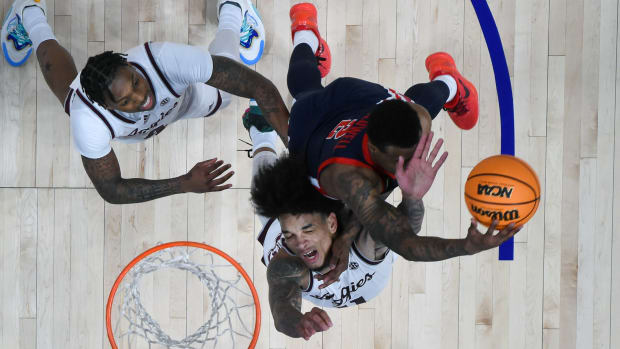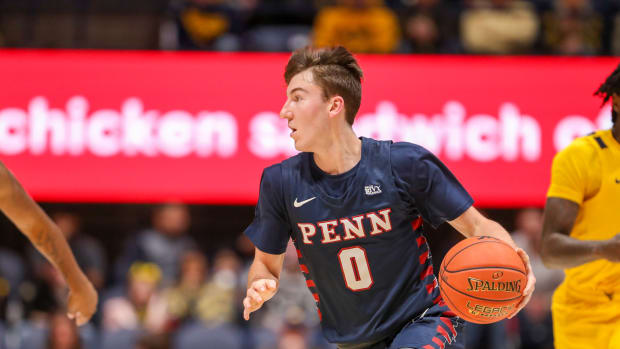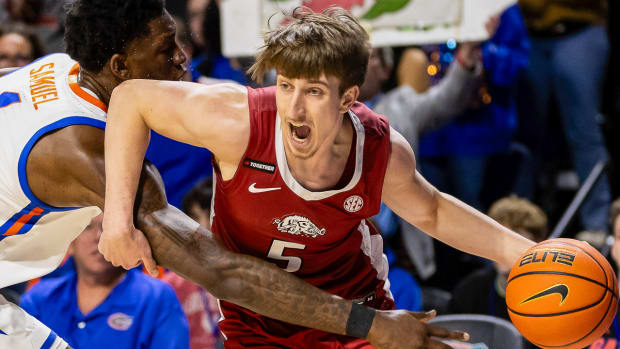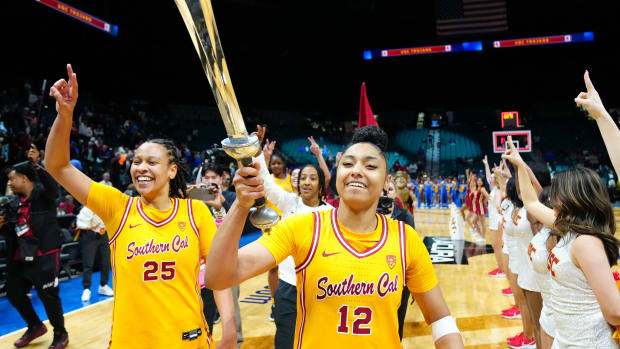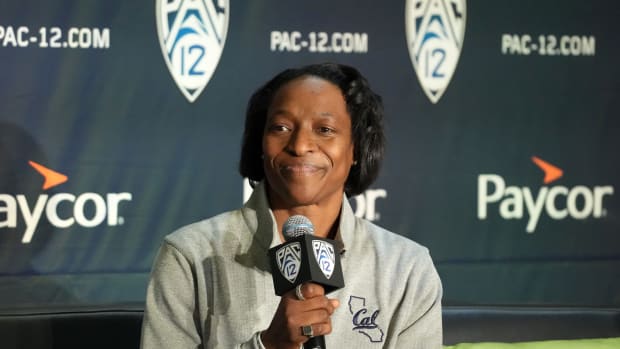The Next Loyola-Chicago? Eleven Mid-Majors Who Could Have a Cinderella Season
We can't all be Loyola-Chicago—but it's almost a guarantee that there will be at least one Cinderella team in the 2019 NCAA tournament. Heck, maybe two. They might not reach the Final Four, but it's becoming increasingly a given that some mid-major team will find its way to the second weekend.
How to identify a Cinderella? A few things: There needs to be depth. Running a six-man rotation is a recipe for disaster against a high major. There needs to be a legit star or two—having a conference player of the year never hurts. The team needs to excel at one thing—maybe it's shooting, maybe it's rim protection. Loyola-Chicago had all of those things.
We're excluding Sister Jean's favorite team from this list, given that they appear on most Top 25 rankings. But here are 11 teams that could easily follow in Loyola's footsteps and make a deep run this March.
Harvard
Harvard returns almost its entire roster, including its five top scorers and top three rebounders. Key returnees are Seth Towns, the Ivy League Player of the Year, and Bryce Aiken, who was the Ivy League Rookie of the Year as a freshman. Towns suffered a knee injury in the Ivy League championship game that certainly hurt Harvard's chances at an NCAA bid. Aiken only played in 14 games last season. Both are healthy and ready to create the type of inside-out combo that could prove devastating in March. The Ivy League is tough—Penn, Princeton and Brown are all contenders—but no one matches the depth of the Crimson.
South Dakota State
Mike Daum is the star of the show. Now a senior, the 6'8" forward is a two-time Summit League Player of the Year. He averaged 23.9 points and led the Jackrabbits to their third-straight tournament a year ago. And it's not just Daum in Brookings. David Jenkins averaged 16.1 points per game as a freshman. The Jackrabbits return four starters. They're pretty much a shoo-in for the Summit League automatic bid. Another year of Jenkins will help take some pressure off of Daum, as will Telvin King, who was second on the team in rebounds (5.6). The key will be depth around Daum. The Jackrabbits weren’t much more than Daum (27 points) and Jenkins (16) in their first-round loss to Ohio State last year. More will be needed to make a run—but they have a generational talent in Daum who could key a long postseason.
64 Reasons to Be Excited for the 2018–19 College Basketball Season
Illinois State
Illinois State was a bit disappointing last year, finishing 18–15. And they play in the really tough Missouri Valley Conference, with Loyola-Chicago and Southern Illinois. But this team is high on talent. Milik Yarbrough was first-team all conference last season, averaging 16.6 points and 6.6 rebounds. He's a sleeper All-America candidate, though his status to open the season is uncertain after being suspended following a September arrest. Phil Fayne was second-team all-MVC, averaging 15.6 points and 7.4 rebounds. There are four starters returning, and a lot of seniors. The Redbirds will have to get past Loyola, but there isn't a more dynamic player in the conference than Yarbrough.
Buffalo
You could easily make a case that Buffalo isn't a Cinderella anymore. The Bulls won 27 games, and blew out Arizona in the first round in March. They return five of their six leading scorers, and seniors Jeremy Harris, Nick Perkins and CJ Massinburg all averaged more than 15 points per game. Ronaldo Segu is a good-looking freshman guard. This is a talented and deep team that could easily surpass its second-round trip from a year ago.
Western Kentucky
The Hilltoppers reached the semis of the NIT, but they only return two starters from that team. That might be O.K. Charles Bassey was a five-star recruit, and he's a one-and-done candidate. Joining him in Bowling Green are four-star guards Dalano Banton and Jeremiah Gambrell. Desean Murray, who started at power forward for Auburn, is now on board. Returning, too, is Taveion Hollingsworth (13.3 ppg) and Lamonte Bearden (11.8), though the latter is ineligible for the first semester. There will be a lot of pressure on the freshmen, especially Bassey, but there's a nice mix of experience and youth that could propel Western Kentucky on a deep run.
Marshall
Jon Elmore and C.J. Burks might be the backcourt combo you haven't heard of. Elmore is an All-America candidate. He led the team with 22.7 points, along with 6.8 assists and 5.8 rebounds. The high-tempo Thundering Herd lose Ajdin Penava, who averaged 15.6 points, and they're a little lacking in the size department. But the Elmore-Burks combo is electric and could easily combine for 60 in a tournament game.
UNC Greensboro
Francis Alonso, the leading scorer for reigning Southern Conference champ, is back, as is Defensive Player of the Year James Dickey. The Spartans only had two double-digit scorers, and one is gone (Marvin Smith). But they're one of the better defensive teams in the nation, and they used that formula to nearly knock off Gonzaga in the first round last March. Keep an eye out on Kaleb Hunter. A redshirt freshman, he missed his senior year of high school due to injury, but averaged 24 points as a junior in Raleigh.
Wofford
Wofford will have to go up against UNC Greensboro for the conference bid, but the Terriers have one of the country's best scorers in Fletcher Magee. The 6'4" guard averaged 22.1 points, shooting a ridiculous 43.9% from the perimeter. And it's not just him. The Terriers return their top six scorers from a team that knocked off North Carolina in Chapel Hill last December, including center Trevor Stumpe. Get Magee in a tournament game, and he could easily go off.
Which First-Year Coaches Are Best Positioned for Success in 2018–19?
Montana
Another dynamic backcourt, this time with Ahmaad Rorie and Michael Oguine. Oguine led the Grizzlies in scoring (17.2) and assists (3.7). Four starters return from a team that made the second round. Seniors Bobby Moorehead and Jamar Akoh started every game last year. And, if healthy, former Washington transfer Donaven Dorsey could be an X-factor. Incoming freshman Freddy Brown won a state title in high school with Michael Porter Jr. He's a good shooter. The Grizz could go far, though, on the strength of the backcourt. At times, it can be nearly impossible to stop.
Lipscomb
Lipscomb made the tournament last season and returns its top six scorers. Garrison Matthews (21.7 ppg) leads the way, and Rob Marberry is a good second threat. A player to watch will be Nathan Moran, who averaged 11.1 points in 2016–17 but took a medical redshirt last year. Also joining the roster is Matt Rose, a transfer from Samford who was an Southern Conference all-freshman selection. If those guys can make an impact, then the Bisons possess one of the better all-around rosters for a mid-major.
Georgia State
If you don't know D'Marcus Simonds, you should. The junior guard averaged 21.2 points last year, and that's despite shooting 29.2% from three. He's a legit NBA prospect. Simonds is joined by three other returning starters from the Sun Belt–winning roster. There's a bit of drop-off after Simonds, but Devin Mitchell is solid, as is Jeff Thomas. Malik Benlevi is a good second-option and a good shooter. Simonds is the key, though, and he's good enough to propel Ron Hunter’s team on another nice run.
